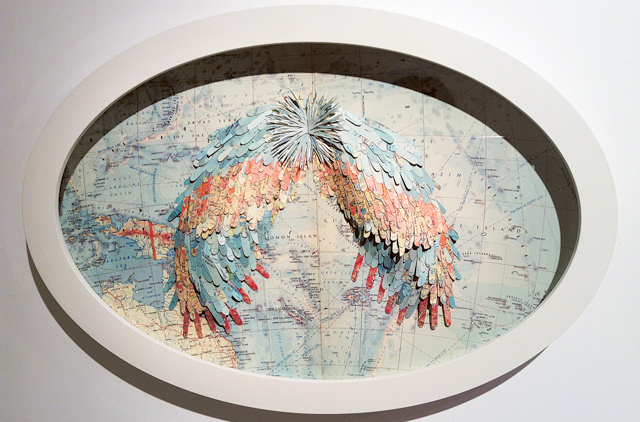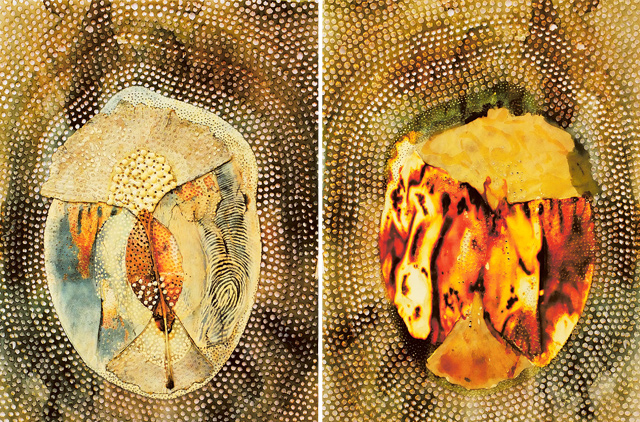
XVA gallery’s summer show, “Butterflies in My Stomach”, sets up an interesting dialogue between works done on paper by three women artists from different backgrounds.
Muscat-based Indian artist Debjani Bhardwaj gave up a career as a financial analyst to pursue her passion for art. Her layered paper cutouts, filled with enigmatic figures and botanical drawings, tell thought-provoking stories about contemporary life. South African Barbara Wildenboer uses books, maps and photography to construct artworks that explore various aspects of modern society and the impact of human beings on nature. And Iranian Saba Masoumian, who lives in Italy, takes inspiration from nature to create her delicate, detailed paintings on paper.
All three bodies of work are aesthetically beautiful, but with an underlying message that is disturbing and compels viewers to think about the tension and imbalance in our contemporary lifestyles.
Bhardwaj’s playful pastiches feature figures inspired by children’s literature, films, comics, Indian mythology and pop culture as well as detailed botanical drawings and symbols. The unrelated figures coexist in the same frame seemingly oblivious to one another.
“I am a visual story teller and I am interested in the moments that are too insignificant, insubstantial, unplanned or precarious to be a grand narrative. By capturing these fleeting moments I try to put a microscope on the intimacies of everyday life and to create alternate universes where anything is possible.
“I work subconsciously, thinking with my hands, as I build up a piece layer by layer. So, I learn a lot about myself from the finished work. In most of my works, viewers will sense something vaguely unsettling,” she says.
“Butterflies in my Stomach”, the piece from which the show gets its title, features a girl sitting on a circular carpet engrossed in painting her nails, seemingly unaware of a man sitting on the sofa and a dog in the same room. A boy peeps out of a cupboard in the corner; and the anatomical drawing of a stomach with butterflies inside it is painted on another woman in the room in a humorous illustration of the phrase in the title.
“The dog represents the undercurrent of violence in our lives, while the boy in the cupboard conveys a feeling of being trapped. The girl on the carpet is a contemporary interpretation of Sita from the Indian epic Ramayana and the line (Lakshman rekha) drawn around her to protect her. This dysfunctional family reflects the isolation, alienation and uneasiness of urban life,” Bhardwaj says.
Wildenboer studied English literature and psychology before doing her Masters in Fine Art, and her interest in these subjects is reflected in her work.
“The artworks I am presenting here are from a series titled ‘Disjecta Membra’, which means disjointed parts, and refers to fragments of poetry or fragmentary quotations. It explores the way names from Greek mythology are often used as scientific names in natural history; how classical mythology has been referenced in poetry, ecology, psychology and contemporary environmental philosophy; and how these different fields of study are interconnected,” she says.
The series includes works made from cuttings of world maps such as a set of oval pieces titled ‘Creation Myths’.
“This is about the multitude of myths regarding the creation of Earth, and the fascinating similarities between these stories from different places and cultures,” Wildenboer says.
Other works have been created by cutting books, which the artist insists is not an act of violence or disrespect. “People often react emotionally to the destruction of books. But this continues to happen not only through acts of book burnings but also through institutionalised obliteration of literature for ideological, economical or other reasons. I see books as receptacles for ideas, and these works should be viewed not as destruction but as a transformation of an object or idea.
“By cutting and altering these books, I become more aware of their materiality and of the difference between a book as an object and a text as an abstract concept,” she says.
In a work titled “Ariadne’s Thread”, the circular cuts on a book seem to be a reference to the World Wide Web. “This work does touch on the uncertain future of printed books due to the increased popularity of digital alternatives. But the shapes are derived from the idea of fractals — the patterns found in the veins of leaves, human arteries, branching of trees and rivers. Like the World Wide Web, there seems to be an interconnected network that links all forms in nature on the macro and micro level.
“The title of this work comes from the mythological story of Ariadne, who handed Theseus a ball of string so that he could find his way out of the maze after slaying the Minotaur. The threads refer to inter-textual links that tie different ideas together,” the artist says.
Similarly, in a photographic work, “Data Stream”, she has used pins connected with thread on photographs of clouds and textual fragments to convey the idea of a flow of information in the virtual cloud data storage systems on the internet.
And in ‘Rorschach’, she has combined a well-known tool in psycho-analysis with the world map to reference the new field of eco-psychology, which looks at the impact of a stressed environment on stress related mental disorders.
Masoumian expresses her love for nature and her concern about the environment through her fragile mixed-media paintings of leaves, flowers and fruits. Tiny holes punched into the paper allow the light to shine through. The paintings are displayed as free standing pieces, placed between transparent acrylic panels, allowing viewers to see both sides.
“One day I was walking in the park and the leaves on the ground caught my attention. I picked them up and stuck them on transparent papers and painted on them. And that is how this series began. The tiny holes in my paintings symbolise the fossilisation of organic forms in nature,” she says.
– Jyoti Kalsi is an arts enthusiast based in Dubai.
“Butterflies in my Stomach” will run at XVA gallery until September 3.













